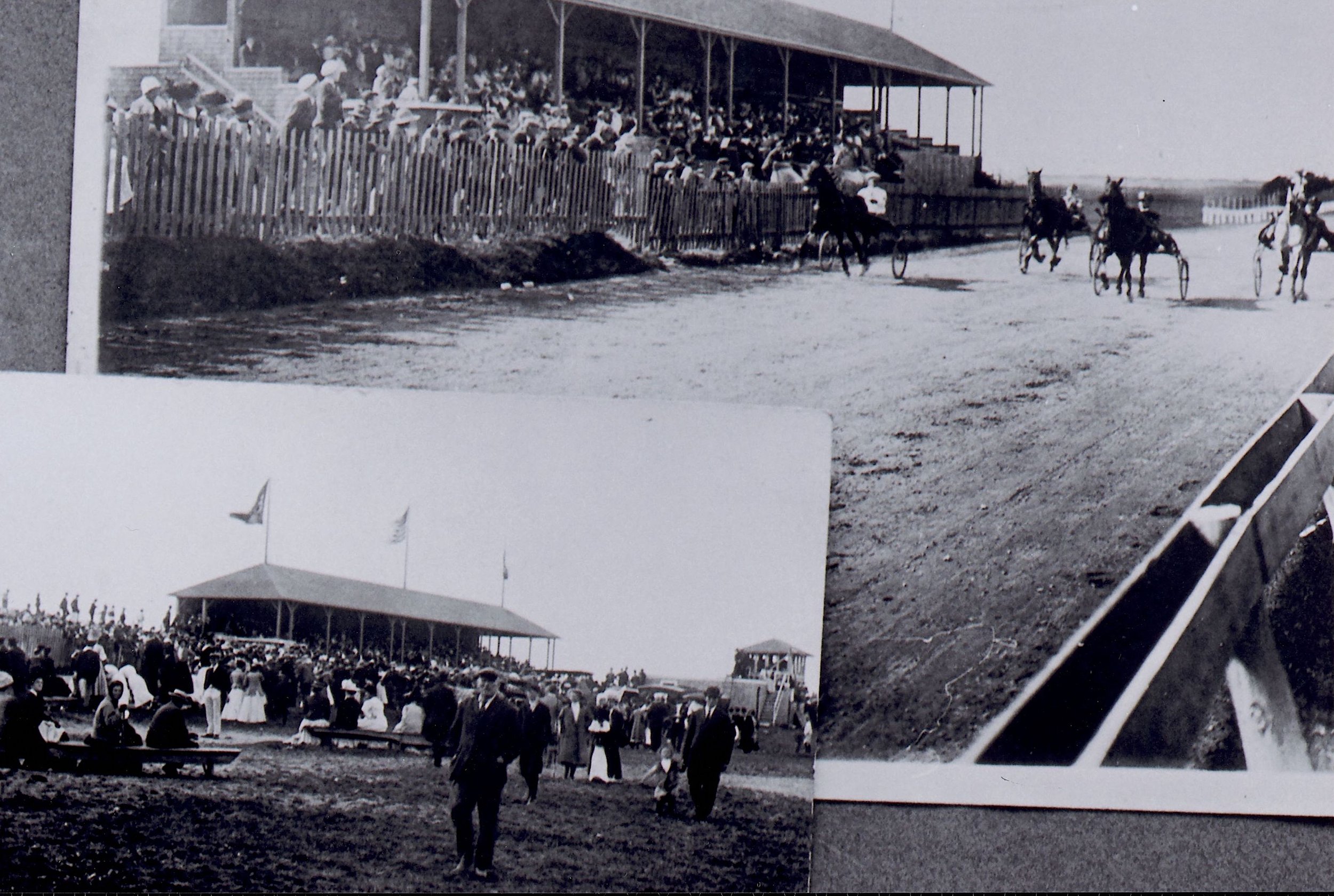In the period between 1850 and 1900, there were as many as ten racetracks on Cape Cod. In 1900 the Cape’s population was just below 30,000, meaning that there could have been one racetrack for every 3000 people on the Cape. How did that small a population support so many tracks?
People have always enjoyed seeing who is the fastest, whether it be on foot, on the ocean, or racing horses. In fact, the first racetrack in America was built on Long Island in 1665, less than 40 years after it was founded. Cape Cod’s first racetrack was built only after the Barnstable County Fair found a permanent location in Barnstable Village when true harness racing replaced informal carriage races.
Photos of sulky racing at the Barnstable County Fair.
Harness racing with high-wheeled sulkies made its appearance in the 1830s in America. The sport became very popular after the Civil War and in 1891, the development of the low-wheeled sulky ushered in the modern era of harness racing and they became a favorite at county fairs.
Horses who pulled these sulkies could be either trotters or pacers. Cape Cod seemed to favor trotters, as they frequently named their racetracks “trotting parks.” The horses at these trotting parks ran counter-clockwise, contrary to the British who ran clockwise.
One of the earliest notations of racing on Cape Cod was published in the Yarmouth Register on October 19, 1855. “Lively Times on the Dennis and Yarmouth Road. Two Cape captains, one Dennis and one Yarmouth were racing their steeds to their hearts’ content…. We suggest that an additional tax be imposed on the owners of all “fast teams” that we may be able to keep our County roads in some sort of repair.”
While the competitive spirit of sea captains with their vessels has been well documented, they didn’t lose this spirit when they came back home. It was only natural that racetracks would be established throughout the upper and mid-Cape region.
Barnstable County Fair had the first major track. It wasn’t until the fair settled permanently at Barnstable (it had been at Sandwich and Orleans as well) that a track was built. Its first year of operation was 1860. There are many pictures of sulky races on it, and there was a baseball field in the middle of the track. Pictures show a large grandstand. In 1896, there were more than 3000 people at the fair race, watching races with purses of up to $300. The 3000 in attendance represented more than 10 percent of the entire Cape Cod population - at that one event. The Barnstable Fair’s track was the only track to remain after World War I.
Barnstable Count Fair with the baseball diamond at center.
There were other tracks as well. In the book, Three Centuries of the Cape Cod County, it was reported that in 1876, “Nearly all the villages of Barnstable had trotting parks at the time.” While some can’t be identified, several have been. Hyannis had its own Trotting Park. Twenty six shareholders bought stock and the first races were held July 4, 1876, on America’s Centennial Celebration day. More that 300 carriages and 1200 spectators attended the grand opening, but an even larger crowd of 2000 was noted at an August race. The track is no longer there, but was located in the woods in back of the present airport, near where Mary Dunn Road used to run all the way to Hyannis. The track even had permanent bleachers, formed in a semi-circle.
The furthest east track was in Harwich at Wychmere Harbor. Originally the harbor was a pond, called Salt Pond, and sea captains raced around it. The track became the “sporting center” of the Cape.
Charles D. Cahoon’s 1888 painting of the Salt Pond racetrack.
The pond was near Nantucket Sound and the captains built a dike to keep the track from being washed away. Sea captains racing on the track used nautical terms when talking to their horses, something an inland horse could not have made head or tail of. The first race was on July 4, 1881, and there were no money stakes. It was reported that this caused a “disinterested feeling among the horsemen.” Later a storm tore apart the dike and a permanent channel was dug into the pond in February of 1887. Local lore has it that wives played an important part in making the opening from the pond to the sea permanent!
Dennis had its own track, known as the Riverside Trotting Park. The track was started in 1890 when shares were sold for $5.00 each. Many of the shareholders were sea captains. The track was made of clay, 6 inches deep, and a six foot fence surrounded the grounds. By 1891, it had a grandstand which could seat 200 as well as stables for 27 horses.
Stables at Trotting Park.
There were four or five big races a year. Attendance averaged about 300, with an admission fee of 50 cents. A special race was reported in the Yarmouth Register on June 3, 1893; a large purse was offered and the article stated “Ladies are assured that everything objectionable will be eliminated.” There was a baseball field there as well. A later article about this racetrack noted – perhaps with tongue in cheek – that “sea captains never bet; they loved it for the sport, not speculation.”
Today, Trotting Park Road leads to the location and Trotters Lane was built over the half mile track and it is now filled with houses.
Falmouth had the Falmouth Gentlemens’ Driving Club, started in East Falmouth in 1896. Located off Gifford Street and Locustfield Road, more than 1000 spectators watched races there. The track had a very short life, opening in 1896 and closing in 1902. On its 24 acre site, it had a 200 yard oval clay track, built to National Trotting Association standards. West of the track was a 12 foot high bank which was a perfect spot to watch races. Bicycle races, which were very popular at the time, were also held there.
Falmouth’s track.
Even the Cape Cod Canal had ties to horse racing. The person investing the millions to build the Canal in the period 1909-1914 was even more famous in financial and horse racing circles. His name was August Belmont, and he and his family started the Belmont Stakes, one of the three most famous races in American horse racing history. The other two? – the Kentucky Derby and the Preakness; the three races being the jewels of horse racing’s Triple Crown.
August Belmont Jr.
By the early 1900s, small tracks were faltering not only on Cape Cod but throughout the United States. Some of the trotting parks even held clambakes to try to build interest. The rich were no longer keeping fast horses; they now had turned to the automobile for speed, and with it, another part of Cape Cod’s past faded into history.
Researched and written by Duncan Oliver
Watching the races at Barnstable County Fair. From left, Caroline Knowles, Frank Knowles, father of Caroline, Adelaide Otis, Watson Thacher.











